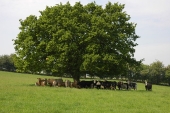
 2
2




 5
5




Our Destination is Our Legacy
www.peacefulvalleyfold.com
 2
2




Elena Sparks wrote:If you do rotational grazing, you'll probably be fine with two or three sheep. I will warn you that you'll need to have a plan in place for lambs (assuming you get a breeding trio, or get ewes find a ram nearby). They multiply fairy fast, and it can be super easy to forget your goal number and end up with tons of sheep (speaking from experience), so make sure you're willing to butcher or sell any sheep that go over your max. Goats may do better with your pasture, but sheep will probably do pretty well. They will eat any and all trees, so if you want to keep your trees living, only run the sheep with the trees that are big enough that the branches won't be eaten. If your grass grows quickly, you may even be able to run five or six, if you managed it well. I'd run the geese with the sheep, if I were you. We've tried running our chickens (before we got geese) with, after, and before the flock of sheep, goats, cows, and alpacas, and running with was definitely the best. If you run them before, they will eat too much for the sheep to have any, and they will contaminate everything else. Running them afterwards means the sheep will have eaten the best grasses, and the geese won't want to eat the rest. If you run them together, then they will balance each other out. The 164 fences are nice because they're so long, but I wouldn't recommend the ones with stiff inner poles. The inner poles themselves were great, but the fences were too hard to tension and the gaps in the netting itself were to big. We've only ever lost two sheep to the net fence, and they were both to a 164 footer. Maybe do two 100 footers to make a fifty by fifty foot paddock? There are also 50 footers, but they fall apart super easily and are actually longer than fifty feet. I will note that with sheep you need to be super careful to balance how much they need to eat out of the pasture, and how much they want to eat out of the pasture. If you push them too long and force them to eat too much off of it, they will learn to break out of the netting (sounds impossible, but believe me when I tell you it isn't, lol). On the other hand, they will often think they're done when they've eaten their favorite bits and nothing else, so make sure that you know the right balance.
All in all, I think your plan sounds pretty good!
 4
4




J. T. Everett wrote: I think grazing the geese alongside the sheep will work fine, I just hope the geese aren’t too mean. They can be a bit cantankerous…
I expect there will be a learning curve as I’ve never raised ruminant animals. I do plan on getting two ewes and an unrelated ram. I was going to try and use the ram aprons to keep breedings scheduled (perhaps it’s wishful thinking). I hope the apron actually works and I can keep them from breeding till November/December. If it fails I do have a large garage and a chicken shed that can be modified to be a lambing stall LOL
I do plan on raising the lambs produced for meat. Barbados are not very big so I doubt I’ll be setting any carcass records but I think they make up for it in their parasite resistance and durability.
I was doing math and taking measurements of the property and I can have something like 41 paddocks depending on how I set up the netting. I don’t think I will need to rest longer than that between moves. I have accepted that 24-48 hrs maximum will be spent on each paddock.
As for the trees I would like a few cedar to stay and be windbreaks and privacy between my neighbors property and mine but everything else I wouldn’t mind if they ate completely gone. I though maybe goats would be better, but I’m just not big fan of goats for some reason. I’ve heard they’re even harder to contain than sheep and they will graze standing up on hind legs. They just seemed wilder. I’ve also never eaten goat meat. I find lamb/some mutton to be delicious
Our Destination is Our Legacy
www.peacefulvalleyfold.com
 2
2




 3
3




Our Destination is Our Legacy
www.peacefulvalleyfold.com












With appropriate microbes, minerals and organic matter, there is no need for pesticides or herbicides.

|
"Ace of Hearts" sounds a little like "Ace o Farts" - says this tiny ad:
The new kickstarter is now live!
https://www.kickstarter.com/projects/paulwheaton/garden-cards
|





